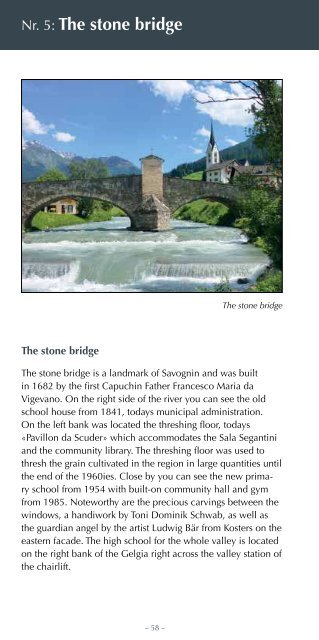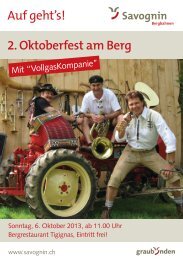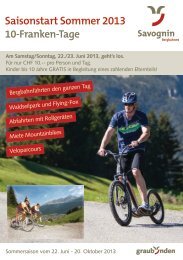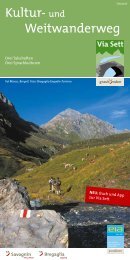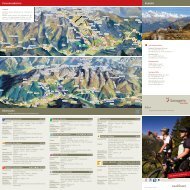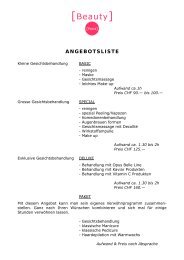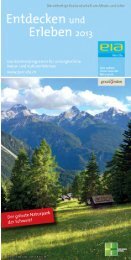Spassegio cultural tras vischnanca - Savognin
Spassegio cultural tras vischnanca - Savognin
Spassegio cultural tras vischnanca - Savognin
You also want an ePaper? Increase the reach of your titles
YUMPU automatically turns print PDFs into web optimized ePapers that Google loves.
Nr. 5: The stone bridge<br />
Nr. 6: The Amilcar residence<br />
The Amilcar residence<br />
The Amilcar residence catches one‘s eye because it‘s very<br />
different from the typical local building techniques in its size<br />
and shape. The house is a very old building which was probably<br />
originally a tower house, adapted and enlarged to the<br />
needs of different periods over the years. The log construction<br />
and the hipped roof show south german influence and were<br />
built in 1638. From that time originate also the illustration of<br />
the Mother of God and the ornaments with pagan motives.<br />
The pictures of the Mother of God are typical for this part of<br />
the village and can be found on various other buildings as<br />
well. Inside the building there are many rooms with beautiful<br />
arched or gothic ceilings as well as precious antique furniture.<br />
The house was renovated in 1990 and is under a preservation<br />
order.<br />
The stone bridge<br />
The stone bridge<br />
The stone bridge is a landmark of <strong>Savognin</strong> and was built<br />
in 1682 by the first Capuchin Father Francesco Maria da<br />
Vigevano. On the right side of the river you can see the old<br />
school house from 1841, todays municipal administration.<br />
On the left bank was located the threshing floor, todays<br />
«Pavillon da Scuder» which accommodates the Sala Segantini<br />
and the community library. The threshing floor was used to<br />
thresh the grain cultivated in the region in large quantities until<br />
the end of the 1960ies. Close by you can see the new primary<br />
school from 1954 with built-on community hall and gym<br />
from 1985. Noteworthy are the precious carvings between the<br />
windows, a handiwork by Toni Dominik Schwab, as well as<br />
the guardian angel by the artist Ludwig Bär from Kosters on the<br />
eastern facade. The high school for the whole valley is located<br />
on the right bank of the Gelgia right across the valley station of<br />
the chairlift.<br />
The Amilcar residence approx. 1900<br />
– 58 – – 59 –


